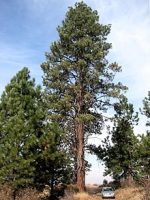 Ponderosa pine is a large confierous evergreen tree native to rocky cliffs and dry slopes in mountainous regions of western US from southwestern North Dakota, south the Texas and west to Washington, Oregon, and southern California. It is known by a variety of names including western yellow, bull, blackjack, big heavy, western red, western pitch, Sierra brownbark, ponderosa white, and western longleaf pine. Ponderosa pine belongs to the Pinaceae plant family that also includes spruce, hemlock and larch, and is divided into 5 different subspieces/varieities. The trees grow from a spreading root system with deep a tap root and can reach 230′ in their native habitat but are normally 60-100′ tall in cultivation. They have a straight main stem that is blackish-brown when the trees are young but develops yellow to orange-red bark in broad plates with deep irregular fissures when mature and is fire resistant. The bright-green needles are usually in bundles of 2-5, and vary in lenght from 2.7-10″ long depending on the subspecies. Pollen and seed cones are produced in the spring. The yellow to red pollen cones are cyllindrical and .6-1.4″ long. The seed cones are solitary (rarely in pairs) and mature in 2 years . They are reddish brown and conic to ovoid before opening to broadly ovoid and becoming 2-6″ long, and prickly. Ponderosa pine is tolerant of high elevation, a wide range of soils including alkaline, low humidity, wind, and drought when established. It is useful for windbreaks and bufferstrips. The genus name, Pinus, is the ancient Latin name for the plant. the specific epithet, ponderosa, is the Latin word meaning heavy or weighty, and refers to the wood, which is valued as lumber.
Ponderosa pine is a large confierous evergreen tree native to rocky cliffs and dry slopes in mountainous regions of western US from southwestern North Dakota, south the Texas and west to Washington, Oregon, and southern California. It is known by a variety of names including western yellow, bull, blackjack, big heavy, western red, western pitch, Sierra brownbark, ponderosa white, and western longleaf pine. Ponderosa pine belongs to the Pinaceae plant family that also includes spruce, hemlock and larch, and is divided into 5 different subspieces/varieities. The trees grow from a spreading root system with deep a tap root and can reach 230′ in their native habitat but are normally 60-100′ tall in cultivation. They have a straight main stem that is blackish-brown when the trees are young but develops yellow to orange-red bark in broad plates with deep irregular fissures when mature and is fire resistant. The bright-green needles are usually in bundles of 2-5, and vary in lenght from 2.7-10″ long depending on the subspecies. Pollen and seed cones are produced in the spring. The yellow to red pollen cones are cyllindrical and .6-1.4″ long. The seed cones are solitary (rarely in pairs) and mature in 2 years . They are reddish brown and conic to ovoid before opening to broadly ovoid and becoming 2-6″ long, and prickly. Ponderosa pine is tolerant of high elevation, a wide range of soils including alkaline, low humidity, wind, and drought when established. It is useful for windbreaks and bufferstrips. The genus name, Pinus, is the ancient Latin name for the plant. the specific epithet, ponderosa, is the Latin word meaning heavy or weighty, and refers to the wood, which is valued as lumber.
Type: Evergreen tree
Outstanding Feature: Tolerance to adverse conditions; very hard wood
Form: Pyramidal aging to cyllindrical
Growth Rate: Moderate to rapid
Bloom: Pollen and seed cones in spring
Size: 60′-100′ H x 25′-30′ W
Light:Full sun’tolerates some shade
Soil: Average, medium moist to dry, well-drained; drought tolerant when established
Hardiness: Zones 3-7
Care: Low maintenance
Pests and Diseases: Suseptible to Armillaria, Phaeolus schmeinitzii, Fomes pini, Atropellis canker, dwarf mistletoe, Polyporus anceps, Verticicladiella, Elytroderma needlecat, western gall rusty, western pine beetle, mountain pine beetle
Propagation: Cuttings, seeds
Photo Credit: Wikipedia